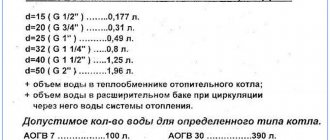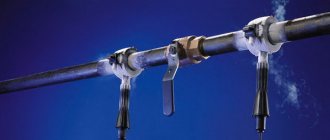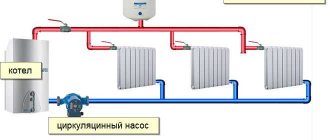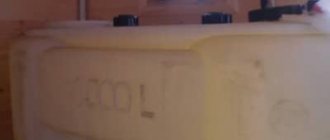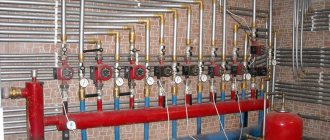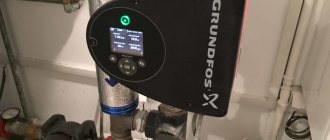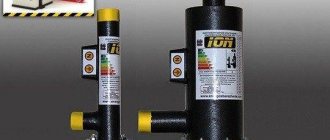Repair and decoration
06/03/2018 Anastasia Prozheva
On the eve of winter cold, the question of how to prepare water for heating systems becomes especially important. Proper water preparation is doubly important for owners of private suburban areas that are not connected to a heating plant and receive water from wells or wells. If the water is hard and contains foreign impurities, for example, iron or manganese, this can lead to failure of not only plumbing fixtures and household electrical appliances, but also damage to heat exchangers, corrosion of pipelines and radiators.
Heating system of a country house.
The first and most important stage of work
The main thing that should be done before planning water treatment measures for a heating system is to conduct a chemical analysis of the composition of the water.
Known (a) and proposed (b) schemes for preparing water for heating: 1 - water heater; 2 — steam-water heater; 3 - refrigerator; 4 - nutrient tank; 5 - high pressure manifold; 6 - low pressure manifold; steam; condensate.
You can carry out tests at home using test kits for aquariums (they are sold at any pet store). However, in order to obtain more accurate values and most effectively prepare water for heating, you should use the services of a certified laboratory.
Water for analysis is collected in a 1.5 liter plastic bottle from non-carbonated drinking water. It is unacceptable to use bottles of sweet carbonated water and other drinks. The cork and bottle are washed well with the same water that is taken for analysis; no detergents should be used. The water is first drained for 10-15 minutes to prevent stagnant water from entering the sample, as this may affect the test results.
To prevent water from being saturated with oxygen dissolved in the air, it is drawn in a thin stream so that it flows down the wall of the bottle. Water is poured under the neck. The bottle is tightly wrapped with a cork to prevent air from entering under it. Oxygen causes chemical processes to occur, and this can also affect test results. If it is not possible to immediately take the samples to the laboratory, then the water can be stored in the refrigerator (not in the freezer!), but no more than two days.
Heating system.
A comprehensive water analysis includes checks for the following indicators:
- rigidity;
- iron;
- manganese;
- pH (degree of acidity);
- permanganate oxidability (indicates the presence of organic substances in water);
- mineralization;
- ammonium;
- oxygen saturation;
- turbidity, color, smell.
If necessary, samples are taken for the presence of microorganisms. Some of them, such as legionella and amoeba, not only can cause serious harm to health, but can also settle inside pipes, forming a slimy microbial film. This promotes corrosion and degrades heating quality.
Related article: Do-it-yourself woodshed at the dacha
Water too hard and too soft
An example of a boiler room diagram for a heating system that provides quick installation and comfortable heating and hot water preparation in a private house, cottage, or country house.
Normal hardness values are 7-10 mEq/l. If this value is exceeded, it means that the water contains an excess amount of calcium and magnesium salts. When heated, the salts form a precipitate known as scale. Accumulating inside pipes and radiators, scale interferes with heat transfer and contributes to wear and tear of the heating system.
The most affordable way to soften water is boiling. During heat treatment, carbon monoxide is removed, and therefore calcium hardness is significantly reduced. However, some calcium remains in the water, so boiling will not completely remove hardness.
Another cleaning method is to use filters with scale inhibitors (neutralizers), such as lime, caustic soda, soda ash. Hard water is also passed through ion exchange resin filters, replacing potassium and magnesium ions with sodium ions.
The use of magnetic softeners is a reagent-free method of water softening. Under the influence of a magnetic field, the properties of water change so that potassium and magnesium salts lose their ability to form as solid sediment and are released in the form of loose sludge. However, salts still remain in the water and need to be removed. In addition, this method is not as effective at water temperatures above 70-75 degrees (that is, the temperature common for boilers, water heaters and boilers).
Rough cleaning and deferrization of all water, water softening for heating and hot water supply (DHW) systems.
Reverse osmosis purification involves forcing water through a special membrane that traps harmful substances. This allows you to completely remove calcium and magnesium salts, which cause scale. But this method also has disadvantages: the high cost of treatment equipment and the consumption of a large amount of water during cleaning (for 1 liter of clean water, approximately 2 to 10 liters are drained into the sewer).
Too soft desalted water, for example, rain or melted water, is no less harmful to the heating system than hard water, since the calcium salts contained in the water neutralize acidic reactions, slowing down corrosion. Therefore, before using rain or melt water for the heating system, you should let it settle for several days and refill it only after making sure that its pH level is in the range of 6.5-8, but not lower. This is especially important if the wiring was made from non-galvanized pipes, which were initially susceptible to corrosion.
How to reduce hardness in boiler rooms
To reduce hardness in the boiler, use:
- Softening filters are the main method;
- Ion exchange filters with multicomponent resin for iron removal and softening;
- Reverse osmosis.
Primary processing of raw water is carried out using mechanical wash-type filters. Here, fairly dense and large impurities are eliminated - sand, clay, silt, colloidal suspensions. After such purification, the water does not get rid of salts and other chemical compounds dissolved in it, but its processing becomes much easier.
In the process of further water treatment to reduce the overall hardness for boilers, the liquid flows to softener filters. These are special containers into which soda ash, lime or sodium orthophosphate are poured. When water passes through such a backfill, chemical reactions occur in it, replacing calcium and magnesium ions with sodium ions. With sufficiently large sizes and relatively slow operation of such filters, it is possible to reduce the salt concentration to an acceptable value of 0.01 mEq/liter. Sodium-cation exchange is used both in industrial water treatment plants and in a number of household filters. In terms of effectiveness and ease of use, softening filtration is in first place and is one of the main ways to reduce water hardness in hot water boilers and other types of boiler equipment.
Filters equipped with electromagnetic emitters are also used. The influence of the field allows you to change the chemical properties of impurities at the molecular level. Hardness salts crystallize and are removed through a filter element. Electromagnetic filters activate impurity molecules and help clean boilers and pipelines from already deposited scale.
Ion exchange resins
The second type of filters used to soften water hardness in a boiler room are units based on solid resins. These are ion exchange filters that work on the same principle as backfill filters, but instead of mineral materials they use ion exchange resins. These are substances that have a porous structure and the ability to actively exchange ions with a solution. Water, when interacting with resins, gets rid of iron, calcium, and magnesium. Resins are insoluble in water and can be cleaned. After washing they become usable again.
Ion-exchange resin filters, which are selected taking into account the results of an analysis of water hardness in the boiler room, are distinguished by their high operating speed, compact size and long service life. In thermal power engineering, ion exchange on sodium group resins is carried out for medium and small-sized boiler houses and for purifying return condensate. Gel and porous resins provide the best quality water for heating systems with minimal energy consumption. But ion exchange cannot provide the same level of minimum concentration as nanofiltration and reverse osmosis.
Membrane units for softening boiler water hardness
Reverse osmosis units belong to equipment for high purification of liquids. The principle of operation is that water is pumped under pressure through a semi-permeable membrane, the pores of which allow water molecules to pass through, but retain all impurities. These include ions of calcium, magnesium, iron and other elements. Water is purified at a chemical level without the use of reagents.
Reverse osmosis is not used independently to reduce water hardness in boiler rooms - it is performed only in combination with other purification methods at the final stage. The membranes are very sensitive and expensive; they can only be supplied with water that has previously undergone mechanical purification and ion exchange processes. After undergoing the reverse osmosis process, many industrial boiler houses use additional degassing of water and equalization of the acid-base balance.
Methods for deferrizing water
Rough cleaning, reagent disinfection and deferrization of all water, elimination of excess chlorine and sorption additional purification of water, water softening for heating and hot water systems.
Related article: Bathroom cornice: how to choose and install?
The maximum permissible iron content in water for technical needs, in particular for the heating system, should not exceed 1 mg/l. The ideal value is 0.3 mg/l. An excess of iron leads to silting of the internal surfaces of pipes and the proliferation of bacteria in the ferrous sediment, which occurs especially actively already at 30-40 degrees Celsius. This leads to rapid wear and tear of the hot water supply and heating system.
The easiest way to deferrize is settling. Under the influence of oxygen, the iron contained in the water oxidizes on its own, forming a rusty sediment. To carry out iron removal yourself, you will need a large tank with a capacity of 200-300 liters and a device for pumping oxygen: a spray unit or a compressor (for small tanks a regular compressor for aquariums is suitable).
To deferrize water, the same method is quite applicable as to soften it - using the reverse osmosis method. Filters with ion exchange resins are also used. To prevent the proliferation of iron bacteria, chlorination (50 mg/l) is used, but first you should find out how resistant the installed water supply facilities are to chlorine.
If the iron content in water is over 5 mg/l (which is not uncommon for water from wells), then filters with glauconite sand enriched with manganese oxide are used for purification. After passing through a filter medium that serves as an oxidation catalyst, the water gets rid of iron, manganese and hydrogen sulfide, which precipitate. When such a filter becomes clogged, it must be washed with solutions that restore its oxidizing capacity (potassium permanganate solution). It should be remembered that with this cleaning method, harmful chemicals are discharged into the sewer system, so it can only be used if there is a centralized sewer system on the site. Removal of mechanical impurities, manganese, microorganisms, oxygen
Rough water purification, removal of dissolved gases, deferrization, sorption purification, water softening and disinfection.
To remove foreign impurities (sand, peat fibers, phyto- and zooplankton, fine clay, dirt, organic substances, etc.), various mechanical filters equipped with washable or removable cartridges are used. For very heavy contamination, pressure filters with granular loading are used (quartz sand, expanded clay, activated carbon, anthracite).
The most obvious sign of the presence of manganese in water is a black precipitate. Its concentration rarely exceeds 2 mg/l, but already at a concentration of 0.05 mg/l, manganese can deposit on the walls of pipes, gradually clogging them. Typically, manganese is dissolved in water along with iron, so that with the de-ironization of water, demanganation also occurs simultaneously. To remove manganese, filters with ion exchange resins are used.
To disinfect water, that is, remove viruses, bacteria, protozoan microorganisms, ozonation, chlorination, and irradiation with ultraviolet rays with a wavelength of 200-300 nm are used.
Related article: Installing doors in a wooden house with your own hands: basic requirements, video
Rough cleaning, reagent disinfection and iron removal, water softening, elimination of excess chlorine and sorption purification of water, final fine cleaning.
The ultraviolet irradiation method is the safest method of water disinfection among the above, since it does not affect its chemical composition, affecting only harmful microorganisms. Water disinfection using UV units occurs in a few seconds.
The corrosive activity of water strongly depends on the presence of oxygen dissolved in it. The dissolved oxygen rate for closed and open heating systems is the same and is no more than 0.05 mg/cub.m. To reduce the oxygen content in water, deaeration units and columns are used.
To prevent oxygen from entering heating systems in other ways (with air), you need to monitor the overall integrity and tightness of the system and not fill it with water too quickly, as this contributes to the formation of air locks. If pipes made of gas-permeable materials, such as polyethylene or polypropylene, are used, they must be protected with an anti-diffusion layer of aluminum.
Flushing the heating system from scale
Rough purification and deferrization of all water, water softening, elimination of excess chlorine and sorption post-purification of water, ultraviolet disinfection.
Proper preparation of water for heating systems includes: mechanical cleaning of contaminants, softening, deferrization, removal of manganese and, if necessary, disinfection and deaeration. Distilled water, settled water, melt water or rain water is suitable for filling into heating systems. Heating water with corrosion and scale inhibitors is sold in specialized stores. It is good because it does not need to be prepared before pouring it into the heating system.
The most thorough water preparation does not eliminate the need to monitor the heating system, especially in a private home. If there is a noticeable deterioration in the quality of operation of the heating batteries, the system is flushed. To do this, the water is drained, then the radiators are dismantled. The bottom of the bathtub is covered with rags, the sewer hole is covered with a mesh to prevent fallen pieces of scale from getting there. Then a radiator with the plugs removed is brought into the bathroom and installed.
Washing is carried out using a flexible hose, removing the shower head from it. The radiator should be turned over periodically when flushing. A metal rod is used to remove large pieces of scale. Flushing is completed when pieces of scale stop being washed out of the radiator and the water becomes clear.
The best posts
- Custom glass partitions: features of modern zoning
- Crochet lace: patterns, mastering lace knitting with easy techniques and master classes
- Plastic entrance doors: photos in private houses
- Openwork cardigan - crochet
- Crochet bell hat: diagrams with description and video
- Why do you need clips for curtains: briefly about the main thing
- DIY hairpin with pearls
- USBI board: types, characteristics, applications of the material
How to add water to the heating system
There are two types of heating systems. These are a closed type heating system and an open type heating system. In an open system, water comes into contact with air. This happens through the tank, which is located at the highest point of the heating system. In a closed system, water does not come into contact with air.
To add water to a closed heating system, you must:
- Have a pump for drawing water from a well or reservoir. Using a hose that is connected to the pump and to the drain pipe, pump up water. All taps open to full capacity. It is important to prevent overflow in the heating system, so you need to constantly regulate the water supply.
- Particular attention should be paid to the pressure with which the pump supplies water, and adjust the pressure required for the heating system. And this is 1.5 atm.
- To calculate the volume of the heating system, you need to know how many liters are in the radiator and one linear meter of pipe.
